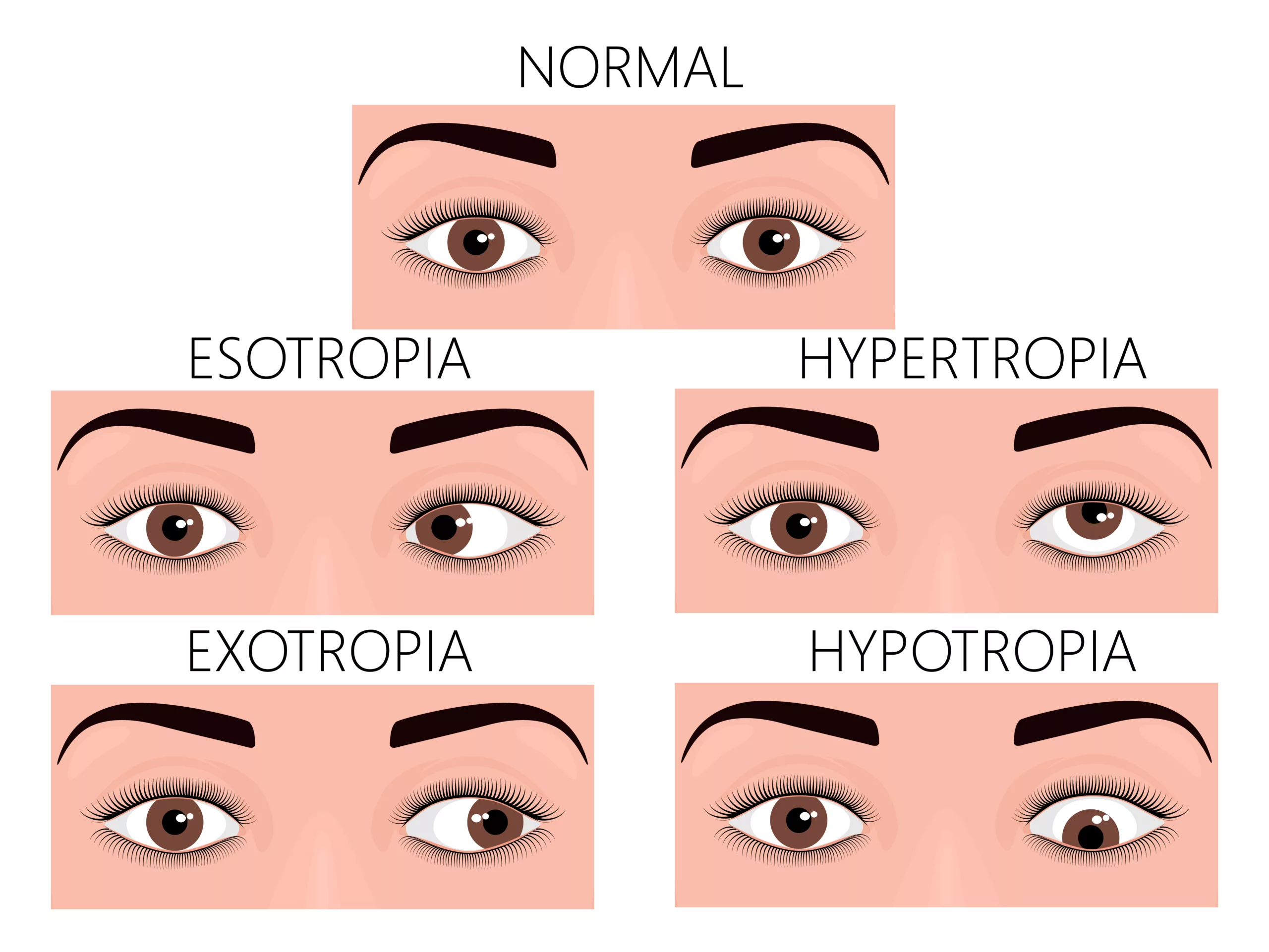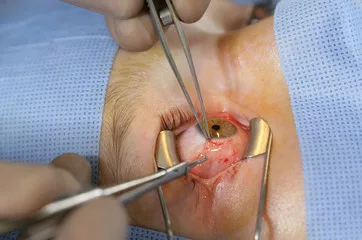Strabismus is an eye disorder in which there is a misalignment of the eyes. One eye looks in a direction that is different from the other eye. It is one of the most common eye diseases, especially in children, and is treatable with early diagnosis.
What is Strabismus?
Strabismus is a visual condition that affects at least 4% of Americans in their life. The word “strabismus” is derived from the Greek term “strabismos”, which literally means “to squint” or “to glance sideways”.
It is usually caused by a pathology in the nerves or muscles of your eyes. As a result, there is poor coordination between both of your eyes, and they point in different directions. They also move at different times. The brain does not receive equal visual input from them either, which causes issues in processing sensory signals from the eye.1Strabismus – American Association for Pediatric Ophthalmology and Strabismus. (2024). Aapos.org. https://aapos.org/glossary/strabismus
Types of Strabismus
Strabismus is usually classified into four main types based on the direction in which the eye is misaligned— esotropia, exotropia, hypertropia, and hypotropia.

Esotropia
Esotropia is a type in which one or both of your eyes are misdirected inwards towards your nose. This deviation from normal leads to a “crossed eyes” look. Other names for esotropia are:
- Convergent strabismus
- Convergent squint
- Internal squint
It affects 1-3% of the population and is common among infants. When left untreated, it may lead to amblyopia, a serious form of vision loss. It has a number of types.2Esotropia – EyeWiki. (2024, April 10). Aao.org. https://eyewiki.aao.org/Esotropia
| Type of Esotropia | Characteristics |
| Infantile Esotropia or Congenital Esotropia | The inward deviation of the eye that happens within the first six months of age. |
| Refractive Accommodative Esotropia | When farsightedness is left untreated for a long period of time, your eye can “accommodate” by turning inwards. It is because of refracting errors in the eye. |
| Non-Refractive Accommodative Esotropia | It occurs even when imbalanced vision, such as farsightedness, has been corrected. It is because of focusing issues in the eye. |
| Partially Accommodative Esotropia | It is the esotropia that is the result of both refracting and focusing errors in your eye. |
| Sensory Esotropia | It is because of longstanding visual problems like blindness. |
| Consecutive Esotropia | Esotropia occurs in the aftermath of surgical correction of another form of strabismus like exotropia. |
Exotropia
Exotropia is a type of strabismus in which one or both of your eyes are misdirected outwards, away from your nose. It is the opposite of esotropia. Other names for exotropia include:
- Divergent strabismus
- Divergent squint
- External squint
It accounts for up to 25% of all eye misalignment issues in children. Like esotropia, it can cause amblyopia. There are many types of exotropia, which are broadly classified into:3Kaur, K., & Bharat Gurnani. (2023, June 11). Exotropia. Nih.gov; StatPearls Publishing. https://www.ncbi.nlm.nih.gov/books/NBK578185/
| Type of Exotropia | Characteristics |
| Pseudoexotropia | False appearance of exotropia when the distance between the pupil of your eyes is more than normal. |
| Exophoria | Also known as latent squint, it is not visible unless a doctor performs a cover-uncover test on your eyes. It is a normal occurrence. |
| Congenital Exotropia or Infantile Exotropia | Exotropia that occurs at birth and does not resolve by 6 months of age. It is often a sign of concern as it is related to disorders such as cerebral palsy. |
| Intermittent Exotropia | The outward deviation of the eye only happens occasionally. It is the most common form of exotropia. |
| Sensory Exotropia | When individuals older than 2-4 years of age develop poor vision or blindness in an eye, it becomes exotropic. |
| Consecutive Exotropia | It is a type of exotropia that can develop after a patient has undergone correctional surgery for esotropia. |
Hypertropia
It is the vertical misalignment of the eye. The visual axis of your affected eye is tilted higher than normal in hypertropia. It is an uncommon form of strabismus. Its types include:
| Types of Hypertropia | Characteristics |
| Constant Hypertropia | When hypertropia is always present. |
| Intermittent Hypertropia | Hypertropia is present from time to time. |
| Comitant Hypertropia | The degree of deviation is the same regardless of which upward direction (e.g., left or right) you look at. |
| Incomitant Hypertropia | The degree of deviation changes with the direction of your gaze. |
Hypotropia
Like hypertropia, there is the vertical misalignment of the eye in hypotropia. However, the visual axis is lower than normal. Examples include:
| Types of Hypotropia | Characteristics |
| Constant Hypotropia | Hypotropia is always present. |
| Intermittent Hypotropia | Hypotropia is present occasionally. |
| Comitant Hypotropia | The degree of deviation is the same irrespective of direction. |
| Incomitant Hypotropia | The degree of deviation changes with the direction. |
Causes of Strabismus
Each type of strabismus has a different cause. However, it is generally caused by damage to the extraocular muscles and nerves and untreated refractive errors such as farsightedness and nearsightedness.
Neuromuscular Disorders
Strabismus is a frequent finding in the nerve and muscle disorders of the eye. As the eye has six major extraocular muscles that maintain its direction, any damage to them or their supply can result in strabismus. For instance:
- Third cranial nerve palsy
- Fourth cranial nerve palsy
- Sixth cranial nerve palsy
- Myasthenia gravis
- Progressive external ophthalmoplegia4Peragallo, J. H., Pineles, S. L., & Demer, J. L. (2015). Recent Advances Clarifying the Etiologies of Strabismus. Journal of Neuro-Ophthalmology, 35(2), 185–193. https://doi.org/10.1097/wno.0000000000000228
Eye Diseases
Other eye diseases can cause or worsen strabismus when untreated, including:
- Amblyopia
- Cataracts
- Farsightedness
- Nearsightedness
- After surgery for eye disorders, e.g. cataract surgery
Congenital Causes
Hippocrates was the first to notice that parents who have strabismus often have children who have it, too. New research has shown that around 18% of people with this condition have a first-degree relative who also has strabismus—the chances of identical twins having it can be up to 82%. You are up to 47% more likely to have strabismus if your non-identical twin is affected by it.
It also occurs in congenital conditions, such as:
- Down syndrome (33% of people with Down syndrome have strabismus)
- Duane syndrome
- Craniofacial syndromes
- Congenital fibrosis of eye muscles
- Low birth weight
- Fetal exposure to drugs
- Neonatal hydrocephalus5Sanchez, M. M., & Whitman, M. C. (2023). Genetics of strabismus. Frontiers in ophthalmology, 3, 1233866. https://doi.org/10.3389/fopht.2023.1233866
Medical Conditions
Strabismus is associated with a variety of medical conditions that can affect the health of your eyes, such as:
- Graves disease (hyperthyroidism)
- Diabetes
- Cushing’s syndrome
- Ischemic stroke
- Hemorrhage
- Brain tumor
- Head injury
- Hydrocephalus
Signs & Symptoms of Strabismus
Strabismus causes a variety of signs and symptoms that are often overlooked and attributed to another cause, especially in pediatric populations:
- A crossed-eye appearance of the eyes
- When eyes don’t move well together
- The reflection seen in both eyes is asymmetrical
- A child may tilt their head to one side, trying to see better
- Squinting with one eye
- Having double vision
- Having reduced depth perception in the affected eye
- Frequently having a headache, especially after highly visual activities
- Developing eye strain more easily and frequently6Yetkin, A. A., & Turkman, I. H. (2023). Evaluation of clinical characteristics and risk factors of strabismus cases. Northern Clinics of Istanbul, 10(2), 157–162. https://doi.org/10.14744/nci.2023.15579
Complications of Strabismus
When this condition goes untreated or isn’t managed well, it can lead to complications like:
- Amblyopia
- Diplopia
- Blurring of vision
- Fibrosis and further weakening of eye muscles
How is Strabismus Diagnosed?
Mild cases of strabismus often go undiagnosed, especially in children. However, a diagnosis is usually made through a thorough eye exam and a detailed medical history.
Medical History
Common questions during the history taking for strabismus include:
- When is the squint present? When did you first notice it? Has it always been there, or has it just developed?
- Are there any other symptoms that you experience alongside the squint?
- Are you taking any medications or drugs? Have you noticed a change in your eyes when you’re on them?
There are certain red flags associated with strabismus, such as a history of recent head trauma or stroke. In addition, sudden development of strabismus in school-going children is also a cause of concern.
Eye Exam
Once they have inspected and generally examined your head and neck, your optometrist or ophthalmologist will conduct an eye exam. Here are the most important steps for detecting strabismus during an eye exam.
Visual Acuity
Visual acuity measures the clarity of your vision. It is the ability of your eyes to differentiate between the shapes and details of an object.
- Strabismus reduces the visual activity of your affected eye, necessitating its measurement during your exam.
- You will be asked to read letters and numbers on a chart placed a few feet away.
- The optometrist or doctor will then calculate the visual acuity in both your eyes.
Cover Testing – Gold Standard
Cover-uncover testing is the most important part of your eye exam when it comes to detecting strabismus. It helps doctors calculate the “posture” or direction of your eyes.
- A healthcare provider will cover each of your eyes alternatingly.
- If present, a deviation will reveal itself even if it usually stays latent or imperceptible.
Hirschberg Test
The Hirschberg test is a simple method of checking for eye misalignment. It is also known as the corneal light reflex test.
- Your doctor will shine a torchlight into your eyes from a small distance.
- They will observe the way the cornea of your eye reflects the light.
- In normal eyes, it appears as a pinpointed white light near the middle of each pupil. However, in strabismus, there is a deviation of the white light, depending on the type of strabismus you have.
Treatment for Strabismus
Strabismus is a manageable condition. It carries an excellent prognosis, and pediatric patients can recover completely if the treatment is started in time. However, it can get complicated if no treatment is undertaken. The best way to treat strabismus is to treat its causes.
Strabismus Glasses, Lenses & Prisms
A variety of visual aids exist for strabismus. These include strabismus glasses, lenses, and prisms.
- Mild cases of strabismus can be managed by a change in your regular eye prescription.
- Your glasses may have special filters to help you see better.
- Prisms are thicker than regular lenses. They restrict the light that enters the eye and the movement of the eyeball, which can reduce double vision.
Vision Therapy
Vision therapy refers to different supportive care treatments or orthoptics, such as eye exercises, which can improve visual skills. It helps you develop better visual acuity and binocular vision.
For instance, an exercise called “pencil pushups” helps the eyes move in toward each other. This allows them to focus on a nearby object at the same time, improving symptoms caused by convergence insufficiency.
Patching
Patching refers to placing a patch on the eye unaffected by strabismus. In strabismus, most of the visual input comes from the unaffected eye, which worsens the squint. By patching up the normal eye, healthcare providers help the affected eye get stronger. In young pediatric patients, this can completely treat strabismus.7Mojon D. (2016). Schielfrüherkennung und Management [Early detection and treatment of strabismus]. Therapeutische Umschau. Revue therapeutique, 73(2), 67–72. https://doi.org/10.1024/0040-5930/a000758

Medical therapy
Different medications are used in combination with other steps of management to help reduce your symptoms. These include:
- Botox (injections, drops, ointments) to control the movement of your eye muscles without surgery
- Atropine stops your healthy eye from focusing on a particular object, thus blurring the visual input you get from it. This way, you can strengthen your strabismus-affected eye without a patch.
- Miotic agents help you see better by changing the refraction of your eye.8Chatzistefanou, K. I., & Mills, M. D. (2000). The role of drug treatment in children with strabismus and amblyopia. Paediatric drugs, 2(2), 91–100. https://doi.org/10.2165/00148581-200002020-00002
Eye Muscle Surgery
Surgery is usually the curative treatment for strabismus, though it is more invasive and risky than the other treatment methods, like strabismus glasses.

Eye surgery depends on the kind of strabismus you have. It is used to loosen or tighten the eye muscles to achieve the desired eye posture.
It is a one-day procedure. To prevent complications, doctors prescribe painkillers, antibiotics, eyedrops, and some rest.
Amblyopia Vs Strabismus
Amblyopia is a problem with eyesight or visual activity in which your eyesight keeps decreasing. Strabismus is a disorder of misalignment and misdirection of the eyes, and if it is left unmanaged, it can lead to amblyopia.
Conclusion
In conclusion, strabismus is one of the most common eye conditions worldwide. It causes the eyes to point in different directions. As a result, your brain does not receive equal signals from both eyes, causing double vision and vision loss. It is treatable with early diagnosis. Management includes medical, nonpharmaceutical, and surgical methods. The prognosis is excellent.
Refrences
- 1Strabismus – American Association for Pediatric Ophthalmology and Strabismus. (2024). Aapos.org. https://aapos.org/glossary/strabismus
- 2Esotropia – EyeWiki. (2024, April 10). Aao.org. https://eyewiki.aao.org/Esotropia
- 3Kaur, K., & Bharat Gurnani. (2023, June 11). Exotropia. Nih.gov; StatPearls Publishing. https://www.ncbi.nlm.nih.gov/books/NBK578185/
- 4Peragallo, J. H., Pineles, S. L., & Demer, J. L. (2015). Recent Advances Clarifying the Etiologies of Strabismus. Journal of Neuro-Ophthalmology, 35(2), 185–193. https://doi.org/10.1097/wno.0000000000000228
- 5Sanchez, M. M., & Whitman, M. C. (2023). Genetics of strabismus. Frontiers in ophthalmology, 3, 1233866. https://doi.org/10.3389/fopht.2023.1233866
- 6Yetkin, A. A., & Turkman, I. H. (2023). Evaluation of clinical characteristics and risk factors of strabismus cases. Northern Clinics of Istanbul, 10(2), 157–162. https://doi.org/10.14744/nci.2023.15579
- 7Mojon D. (2016). Schielfrüherkennung und Management [Early detection and treatment of strabismus]. Therapeutische Umschau. Revue therapeutique, 73(2), 67–72. https://doi.org/10.1024/0040-5930/a000758
- 8Chatzistefanou, K. I., & Mills, M. D. (2000). The role of drug treatment in children with strabismus and amblyopia. Paediatric drugs, 2(2), 91–100. https://doi.org/10.2165/00148581-200002020-00002

